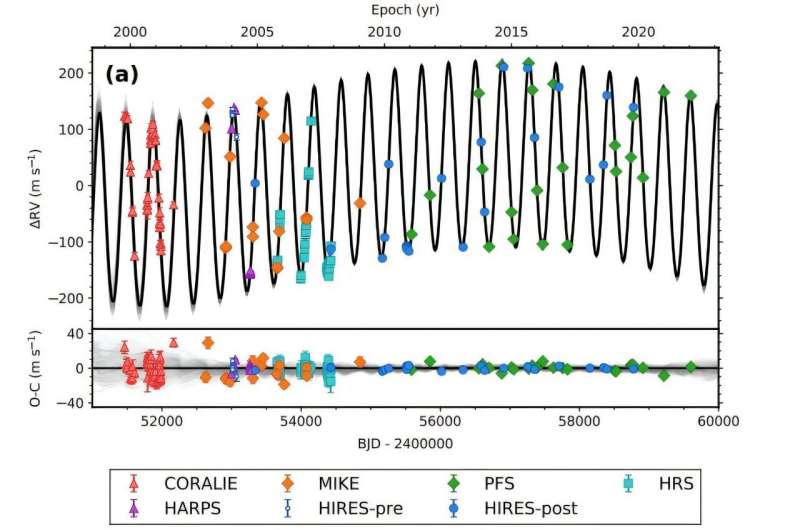Astronomers from the University of Southern Queensland (UniSQ) in Australia and elsewhere have reinvestigated a planetary system known as HD 28185, known to contain a gaseous giant exoplanet and an outer companion, believed to be a brown dwarf. They found that the supposed brown dwarf is a massive super-Jovian planet.
The finding was reported October 10 in the Monthly Notices of the Royal Astronomical Society.
Brown dwarfs (BDs) are intermediate objects between planets and stars, occupying the mass range between 13 and 80 Jupiter masses (0.012 and 0.076 solar masses). Although many brown dwarfs have been detected to date, these objects orbiting other stars are a rare find.
HD 28185 is a sun-like star at a distance of about 127.8 light years, estimated to be 8.3 billion years old. In 2001, a temperate giant planet was detected, which received the designation HD 28185 b. The exoplanet has a mass of at least six Jupiter masses and encircles the host on an Earth-like orbit.
Twenty years later, astronomers identified another object in the HD 28185 system, on a more distant orbit. The newfound object, designated HD 28185 c, was found to have a minimum mass of some 19.6 Jupiter masses and its orbital period was measured to be 47.7 years.
However, now a group of astronomers led by UniSQ’s Alexander Venner, reports that HD 28185 c is much less massive and has a shorter orbital period than previously thought. Their new findings are based on an analysis of 22 years of radial velocity observations conducted using various spectrographs worldwide and precision astrometry from the Hipparcos-Gaia Catalog of Accelerations (HGCA).
According to the study, Veneer’s team found that HD 28185 c orbits its parent star every 9,090 days, which corresponds to 24.9 years, at a distance of approximately 8.5 AU from the parent star. The mass of HD 28185 c was estimated to be about 6.0 Jupiter masses.
Therefore, based on the revised parameters of HD 28185 c, the researchers reclassified it as a super-Jovian exoplanet. Moreover, they noted that due to its orbital parameters, this planet can be regarded as a Saturn analog.
“We establish that this companion is a massive analog of Saturn, having one of the longest orbital periods of any exoplanet found with indirect detection techniques,” the scientists conclude.
The authors of the paper add that their new findings make HD 28185 c an important addition to the sample of long-period giant planets from radial velocity surveys, given that the frequency of giant planets at such wide orbital separations is not yet well-constrained by observations conducted so far.
More information:
Alexander Venner et al., HD 28185 revisited: an outer planet, instead of a brown dwarf, on a Saturn-like orbit, Monthly Notices of the Royal Astronomical Society (2024). DOI: 10.1093/mnras/stae2336
© 2024 Science X Network
Citation:
HD 28185 c is not a brown dwarf but a massive planet, study finds (2024, October 28)
retrieved 28 October 2024
from https://phys.org/news/2024-10-hd-brown-dwarf-massive-planet.html
This document is subject to copyright. Apart from any fair dealing for the purpose of private study or research, no
part may be reproduced without the written permission. The content is provided for information purposes only.

